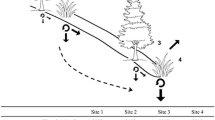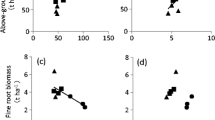Abstract
Variation in rainfall in humid tropical forests has the potential to alter patterns of primary productivity andnutrient cycling. Net primary productivity (NPP) and nutrient cycling were measured at six sites similar in temperature regime, parent material, ecosystem age, vegetation and topographical relief, while mean annual precipitation (MAP) varied from 2,200 toover 5,000 mm/year. Aboveground NPP declined by a factor of 2.2 with increased MAP across the precipitation gradient. Increased water availability in excess of plant demand is likely to have decreased the other resources for plant growth. Patterns of nutrient cycling and other factors that affect plant growth suggest that increased nutrient limitation in wetter sites could be the direct cause of the decline in NPP. Foliar nitrogen (N) and soil N availability decreased with increased precipitation, corresponding with the decrease in forest growth. In contrast, patterns of foliar and soil phosphorus (P) did not correspond with the decrease in growth; P availability was highest at either end of the precipitation gradient and lowest across the middle. Natural abundance of δ15N in foliage and soils decreased with increased precipitation, further supporting the idea that N availability declined. Decreased N availability was associated with a decrease in soil reduction-oxidation potentials. Oxygen limitation in soil microsites was a factor at all sites, but became increasingly widespread at higher MAP regimes. There was no strong evidence that soil oxygen availability, expressed in foliar δ13C values, directly limited plant growth. In addition foliar micronutrients either showed no change (Ca, Mg) or declined (Al, Fe) with increased MAP while soil pH was low but constant, suggesting that toxic elements in the soil solution were also not direct factors in decreased plant growth across the gradient. Thus, the decline in NPP with associated MAP appeared to be most directly associated with decreased N availability in these humid forests. Fluctuating anaerobic conditions that increased in intensity and duration with increased rainfall could be a mechanism that slows decomposition and N mineralization while concurrently increasing P solubility from soil mineral-bound pools.
Similar content being viewed by others
Author information
Authors and Affiliations
Additional information
Electronic Publication
Rights and permissions
About this article
Cite this article
Schuur, E.A., Matson, P.A. Net primary productivity and nutrient cycling across a mesic to wet precipitation gradient in Hawaiian montane forest. Oecologia 128, 431–442 (2001). https://doi.org/10.1007/s004420100671
Received:
Accepted:
Published:
Issue Date:
DOI: https://doi.org/10.1007/s004420100671




